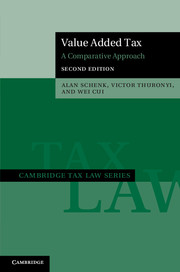Book contents
- Frontmatter
- Dedication
- Contents
- List of Tables and Charts
- List of Cases
- Preface to the Second Edition
- 1 Introduction
- 2 Consumption Tax Forms and Base Alterations
- 3 Varieties of VAT in Use
- 4 Registration, Taxpayer, and Taxable Activity
- 5 Taxable Supplies and Tax Invoices
- 6 The Tax Credit Mechanism
- 7 Introduction to Cross-Border Aspects of VAT
- 8 Timing and Valuation Rules
- 9 Zero-Rating, Exemptions, and Exempt Entities
- 10 VAT Evasion and Avoidance
- 11 Gambling and Financial Services (Other than Insurance)
- 12 Insurance
- 13 Real Property
- 14 An Anatomy of the Chinese VAT
- 15 Interjurisdictional Aspects
- Appendix VATs Worldwide
- Index
- References
6 - The Tax Credit Mechanism
Published online by Cambridge University Press: 05 February 2015
- Frontmatter
- Dedication
- Contents
- List of Tables and Charts
- List of Cases
- Preface to the Second Edition
- 1 Introduction
- 2 Consumption Tax Forms and Base Alterations
- 3 Varieties of VAT in Use
- 4 Registration, Taxpayer, and Taxable Activity
- 5 Taxable Supplies and Tax Invoices
- 6 The Tax Credit Mechanism
- 7 Introduction to Cross-Border Aspects of VAT
- 8 Timing and Valuation Rules
- 9 Zero-Rating, Exemptions, and Exempt Entities
- 10 VAT Evasion and Avoidance
- 11 Gambling and Financial Services (Other than Insurance)
- 12 Insurance
- 13 Real Property
- 14 An Anatomy of the Chinese VAT
- 15 Interjurisdictional Aspects
- Appendix VATs Worldwide
- Index
- References
Summary
Allowance of Credit – General Rules
Under the credit or invoice VAT used almost universally, tax liability for each period is calculated as the difference between the tax chargeable on taxable sales (output tax) and tax charged both on taxable purchases and on taxable imports (input tax credit). Some credit-invoice VATs are worded so that the input tax is deducted from tax on taxable sales (output tax). In this book, input tax credit and input tax deduction are used interchangeably to mean the subtraction of input tax from output tax.
Unlike an income tax imposed on an income base that requires capital goods to be capitalized and depreciated and beginning and ending inventories to be taken into account in determining gross income from sales, VATs typically are consumption-based taxes that allow an immediate input credit for tax imposed on purchases of capital goods and inventory items. There are some exceptions discussed in this chapter.
The EU VAT Directive contains extensive rules on the availability of input tax credits (which the Directive refers to as deductions). An input credit is available for tax on purchases of goods or services, imports of goods, or certain taxable self-supplies if these items are used for purposes of taxable transactions. Taxpayers may engage in tax-motivated transactions in an attempt to convert assets used in making exempt supplies into assets used in making taxable supplies.
- Type
- Chapter
- Information
- Value Added TaxA Comparative Approach, pp. 136 - 186Publisher: Cambridge University PressPrint publication year: 2015



